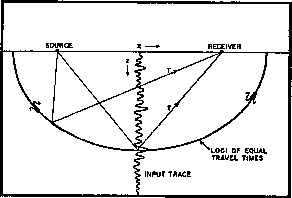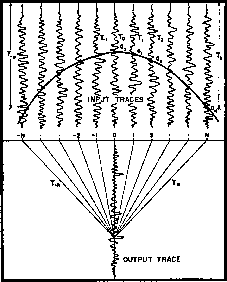The methods of hyperbola summation and semicircle superposition are the most comprehensible of all known methods.
Recall the equation for a
conic section, that is, a circle in (x,z)-space
or a hyperbola in (x,t)-space.
Converting to travel-time depth ![]()
 |
(17) | |
| (18) |
Figure 6, which is from Schneider's classic paper [1971], illustrates the semicircle-superposition method.
 |
Taking the data field to contain a few impulse functions, the output
should be a superposition of the appropriate semicircles.
Each semicircle denotes the spherical-reflector earth model
that would be implied by a dataset with a single pulse.
Taking the data field to be one thousand seismograms of one
thousand points each,
then the output is a superposition of one million semicircles.
Since a seismogram has both positive and negative polarities, about
half the semicircles will be superposed with negative polarities.
The resulting superposition could look like almost anything.
Indeed, the semicircles might mutually destroy one another almost
everywhere except at one isolated impulse in ![]() )-space.
Should this happen you might rightly suspect that the
input data section in (x,t)-space is a Huygens secondary source,
namely, energy concentrated along a hyperbola.
This leads us to the
hyperbola-summation
method.
)-space.
Should this happen you might rightly suspect that the
input data section in (x,t)-space is a Huygens secondary source,
namely, energy concentrated along a hyperbola.
This leads us to the
hyperbola-summation
method.
The hyperbola-summation method of migration is depicted in Figure 7.
|
schneider2
Figure 7 A second description of the process is provided here. The process is represented in terms of how an output trace is developed from an ensemble of input traces, shown as CDP-stacked traces in the upper half of the figure. The output in the lower half reflects how each amplitude value at (x,z) is obtained by summing input amplitudes along the travel-time curve shown. This curve defines a diffraction hyperbola. If a diffraction source existed in the subsurface at the output point shown, then a large amplitude would result. The process also works for reflectors since a reflector may be regarded as a continuum of diffracting elements whose individual images merge to produce a smooth continuous boundary. (figure and caption from Schneider, 1971) |  |
The idea is to create one point in ![]() -space at a time,
unlike in the semicircle method,
where each point in
-space at a time,
unlike in the semicircle method,
where each point in ![]() -space is built
up bit by bit as the one million semicircles are stacked together.
To create one fixed point in the output
-space is built
up bit by bit as the one million semicircles are stacked together.
To create one fixed point in the output ![]() )-space,
imagine a hyperbola,
equation (18),
set down with its top on
the corresponding position of (x,t)-space.
All data values touching the hyperbola are added together to produce a
value for the output at the appropriate place in
)-space,
imagine a hyperbola,
equation (18),
set down with its top on
the corresponding position of (x,t)-space.
All data values touching the hyperbola are added together to produce a
value for the output at the appropriate place in ![]() )-space.
In the same way, all other locations in
)-space.
In the same way, all other locations in ![]() )-space are filled.
We can wonder whether the hyperbola-migration method
is better or worse than or equivalent to the semicircle method.
)-space are filled.
We can wonder whether the hyperbola-migration method
is better or worse than or equivalent to the semicircle method.
The opposite of data processing or building models from data is constructing synthetic data from models. With a slight change, the above two processing programs can be converted to modeling programs. Instead of hyperbola summation or semicircle superposition, you do hyperbola superposition or semicircle summation. We can also wonder whether the processing programs really are inverse to the modeling programs. Some factors that need to be considered are (1) the angle-dependence of amplitude (the obliquity function) of the Huygens waveform, (2) spherical spreading of energy, and (3) the phase-shift on the Huygens waveform. It turns out that results are reasonably good even when these complicating factors are ignored.
As other methods of migration were developed, the deficiencies of the earlier methods were more clearly understood and found to be largely correctable by careful implementation. One advantage of the later methods is that they implement true all-pass filters. Such migrations preserve the general appearance of the data. This suggests restoration of high frequencies, which tend to be destroyed by hyperbolic integrations. Work with the Kirchhoff diffraction integral by Trorey [1970] and Hilterman [1970] led to forward modeling programs. Eventually (Schneider [1977]) this work suggested quantitative means of bringing hyperbola methods into agreement with other methods, at least for constant velocity. Common terminology nowadays is to refer to any hyperbola or semicircular method as a Kirchhoff method, although, strictly speaking, the Kirchhoff integral applies only in the constant-velocity case.